
Have Grinders, Will Travel
August 7, 2009
By Heather Hager PhD
It seems an unlikely location, but just inside the town limits of Truro, Nova Scotia, is the Verboom family’s small sawmill and home base to a substantial biomass grinding operation. Here, Verboom Grinders processes multiple source streams of non-timber-quality wood to supply two biomass markets: wood fuel and landscaping mulch.
It seems an unlikely location, but just inside the town limits of Truro, Nova Scotia, is the Verboom family’s small sawmill and home base to a substantial biomass grinding operation. Here, Verboom Grinders processes multiple source streams of non-timber-quality wood to supply two biomass markets: wood fuel and landscaping mulch.
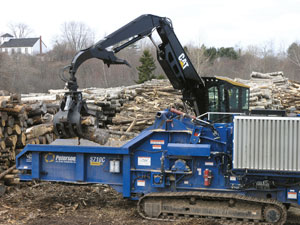
|
|
| The acquisition of a horizontal grinder and a truck with walking floor allowed Verboom Grinders access to additional markets.
|
“We started Verboom Grinders in 1992,” states Jim Verboom, who began the business with his father Cees, who is now “retired,” but can still be found trimming roundwood fence posts in the sawmill. Jim’s son Luke is now a partner in the business and is the resident mechanical guru. “Our first objective with grinding was for our bark mulch business. When we bought our first grinder, it was with the intention of working about three weeks per year,” says Verboom. “By 1993, we got our first biomass fuel job.”
That first grinder was a 1992 Duratech HD-10 tub grinder with 300 hp Cat engine, which worked more than 10,000 hours during its lifetime. “We started out with a tub grinder because we were processing bark sawmill residue,” says Verboom. “We had to make it a consistent size to encourage the landscape industry to use bark. It had to be easy to shovel.” The 1992 Duratech was eventually scrapped to maintain the second grinder, a 1994 model, which is still running today.
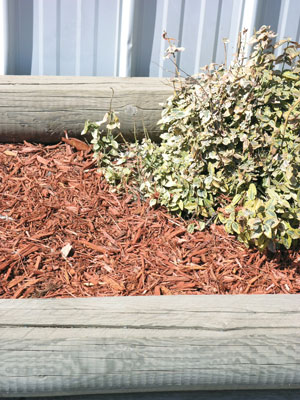
|
|
| The growing popularity of coloured mulch has provided another business opportunity for Verboom Grinders. The company has added a Rotochopper unit to fill this need.
|
The grinding business grew quite slowly during the 1990s, in part because the low cost of oil dampened interest in alternative energy sources. However, because they owned an industrial grinder, the Verbooms began to pick up biomass fuel jobs, industrial and commercial land-clearing work, and wood waste volume reduction work at local landfill sites. Then Hurricane Juan hit Atlantic Canada, toppling thousands of trees and leaving behind a terrible mess.
“When Hurricane Juan hit in late September 2003, we had the existing contract with the city of Halifax to supply grinding services on demand. What that meant was 20 or 30 hours a year,” explains Verboom. The additional work created by the hurricane allowed a second grinder to be added to the fleet: a Duratech 3010 with 450 hp Cat engine.
Chip or grind?
When the time came to choose additional machines for the fleet of grinders, the Verbooms considered the emerging range of fibre supply. “As the demand for biomass started to grow, we saw that we couldn’t supply it economically by taking long trees and cutting them up into short pieces and throwing them in the tub grinder,” says Verboom. “The next step had to be a machine capable of turning full-length trees into fuel.” This left chippers or horizontal grinders.
“A grinder can handle a broader range of fuel [feedstock] than a chipper can, especially fuel that has a little bit of dirt on it,” explains Verboom. At the time, their competitors were already using chippers. So, the Verbooms went with horizontal grinders, acquiring first a Bandit Beast 3680 with 700 hp Cummins engine and then a Peterson Pacific 5710C with 1050 hp Cat engine. Along the way, they also acquired various excavators, a 53-foot trailer with walking floor for transporting processed biomass, and last year, a Rotochopper CP118 grinder with 110 hp John Deere engine to produce coloured landscaping mulch.
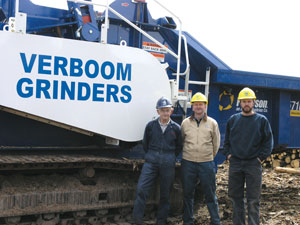
|
|
| Three generations have grown the biomass business: Cees, Jim, and Luke Verboom (L to R).
|
|
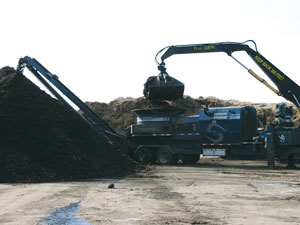 |
|
| A tub grinder is the old workhorse of the Verboom operation.
|
Markets
Verboom Grinders is just one of the family’s three wood products businesses. “For biomass to work for us as one of the first companies into it in Nova Scotia, we had to be quite diversified,” explains Verboom. “We had to have other related products because, when you’re the first one in, it’s very rare to have steady work.” This diversity allows the company to stay busy, and viable, even when one area experiences a slowdown.
To name a few examples, tree seed collecting for the seed supply business begins when the landscape industry slows in early fall. The small sawmill produces various products, including roundwood fencing and landscaping timbers. The slab wood and other mill waste is used for biomass fuel, landscaping mulch, or animal bedding. “If somebody comes to me with a new idea, I hardly ever say no,” says Verboom. “We’ll figure out how to do it.”
In addition to its mill waste, Verboom Grinders receives used unpainted/untreated wood pallets, clean brush trimmings, Christmas trees, and cardboard at the site in Truro. However, this only amounts to 10 or 20 truckloads of biomass fuel per year. “Probably 90 to 95% of our grinding is away from the shop,” says Verboom. “And that could be anywhere from Yarmouth to Sydney to Prince Edward Island.” The company has even worked in Newfoundland.
Most clients are companies with biomass boilers or municipalities looking to reduce landfill volume. Biomass fuel customers include paper mills, combined heat and power (CHP) plants, greenhouses, and institutional buildings. Some customers buy the already-ground fuel, but many buy undesirable species or wood that is of too low quality to be used for pulpwood and have it ground for fuel at the boiler site.
To see a grinder in action, we dropped in at a local wood pellet plant, where one of Verboom’s tub grinders was about halfway through a two-week job. “What he’s digging into right now is actually bark that came from a sawmill, and it’s too stringy,” says Verboom, indicating the excavator operator. “It’s probably 90% stuff they can handle, but there’s just enough that’s not that it’ll plug up their system. Because the tub grinder is so fast and efficient with this material, it doesn’t cost them very many dollars per ton to make it into a form that they can readily use.”
This particular bark is also quite wet and contains frozen lumps, which will plug the pellet plant’s infeed system and associated electric grinder. “Grinders behave differently with different types of feedstock, and they [the pellet plant] just can’t change their grinder every time the feedstock changes. That’s the inefficiency of running a grinder in an infeed system,” explains Verboom. “We can set up for bark, and then if we hit the dry wood and it starts behaving a little differently, we can stop and change screens a lot easier than they can change them in their grinder.” For most of Verboom’s machines, it takes 30–45 minutes to change the screens.
Municipal work is another matter; it can be quite rough on the machines. “Although it looks like there’s good money in municipal work, in most municipalities, people have trouble telling the difference between wood and steel, and as a result, you end up breaking your machinery quite often,” says Verboom, with a shake of his head. In the past, they have recovered up to 100 pounds of steel from a grinder during one week of work. “Some of them are potential meltdowns—when you have a major breakdown that puts your machine out of operation for a while.” Meltdowns can cost anywhere from $10,000 to $25,000 in repairs, plus lost time.
Verboom anticipates at least one meltdown per year doing municipal volume-reduction work. “We keep a couple of old tub grinders around for handling that work so that when we do break something, the repair bill’s a lot smaller.” He says that the older machines tend to be a bit more durable, simply because they have fewer computer controls and electronics and less wiring that might chafe and short out.
A lot of the unpredictability in the business has to do with the fact that only about 5% of the biomass grinding work is pre-contracted. The remainder is supply on demand. The demand is dependent on various external factors, including the availability of mill residues, the cost of alternative fuels such as oil or natural gas, and the demand for electricity.
“Most of the larger consumers of biomass in the province like to use mill residue, but there’s not enough mill residue around to keep everybody going,” explains Verboom. To top up their biomass supply, these consumers will buy from other sources such as Verboom Grinders, but only if they have to, because of the additional expense of the grinding service. “The mill closures were giving us extra work because there were no mill residues to supply the places that usually took them.”
Other grinding work has disappeared, however. “In one case, the price of natural gas dropped so much that a paper mill found it cheaper to burn natural gas for now than burning biomass,” notes Verboom. Another paper mill shut down, reducing its demand for power. This caused a chain reaction in which the province’s power company didn’t require as much electricity supplied to the grid from a biomass-powered CHP plant.
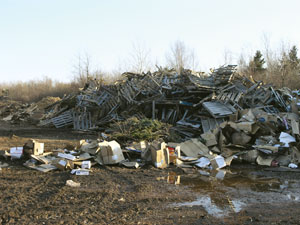
|
|
| Pallets, cardboard, and brush trimmings are small, local sources of biomass.
|
Industry development
Just as important as markets is communication. Verboom thinks that information sharing is critical to developing the biomass industry. Locally, he says that people can be reluctant to share information. “We eye very suspiciously anybody down the street that’s using wood to make anything anywhere close to resembling what we make. Of course, you never figure out enough on your own. I haven’t lost the ability to share information with other people because I learned that lesson pretty quick.” He finds that once people explore outside their local region, they tend to become more open about what they are doing, and in return, learn more.
Back in Nova Scotia, the biomass industry seems to be gaining momentum. “In 2008, two guys bought grinders to compete against us,” says Verboom, “Plus the original two guys there, so now we’ve got five companies that are capable of producing several thousand tons of biomass a year.” He stresses that you can’t have an industry with only a couple of suppliers and a couple of customers. It just makes everyone vulnerable.
He cites the local landfill as an example. “They’ve got five bids now, which has never happened before—five companies able to do the work. That means the landfill can be quite confident the price they’re paying is fair, and they also don’t have to worry about not getting any bids or having no one willing to do it at some point in the future.”
Just a few years ago, a job was a no-go if the customer buying the biomass backed out. “Now we have enough customers that you can actually start to call it an industry and you can proceed with some confidence. That’s where the industry has to go, and for that reason, I don’t mind sharing information. Because I know that doing it alone, I’m not going to survive anyway. It’s too risky.” •
Print this page